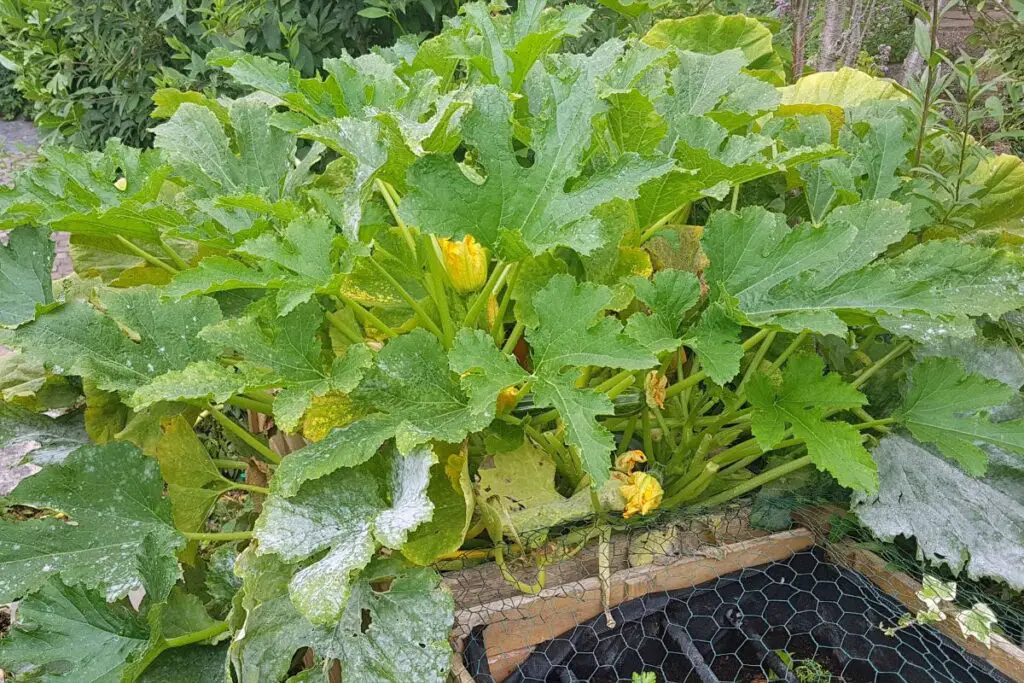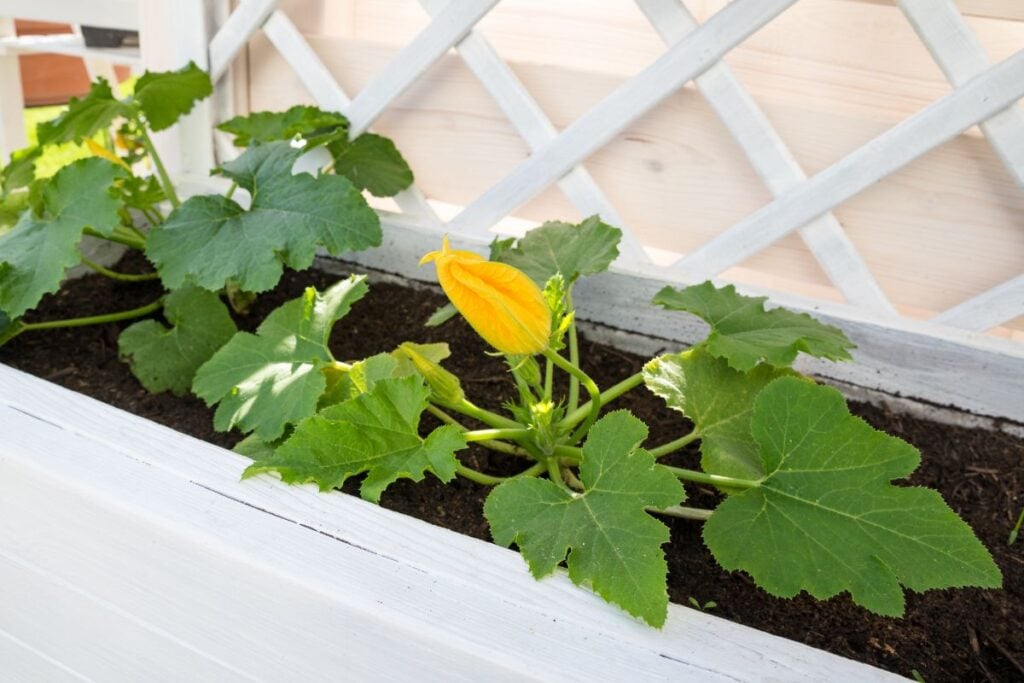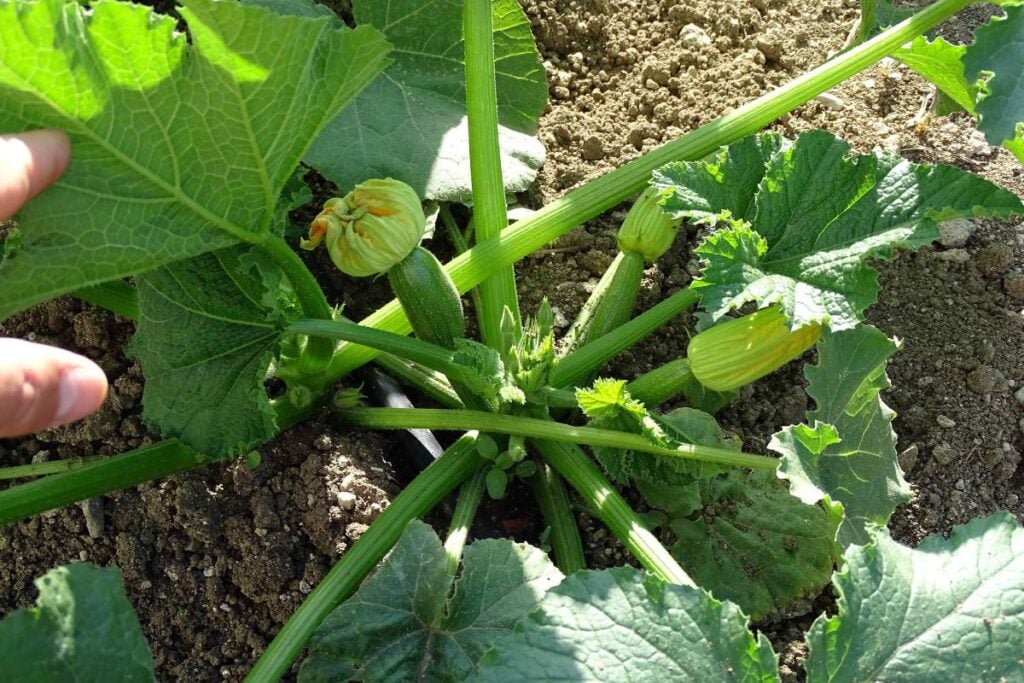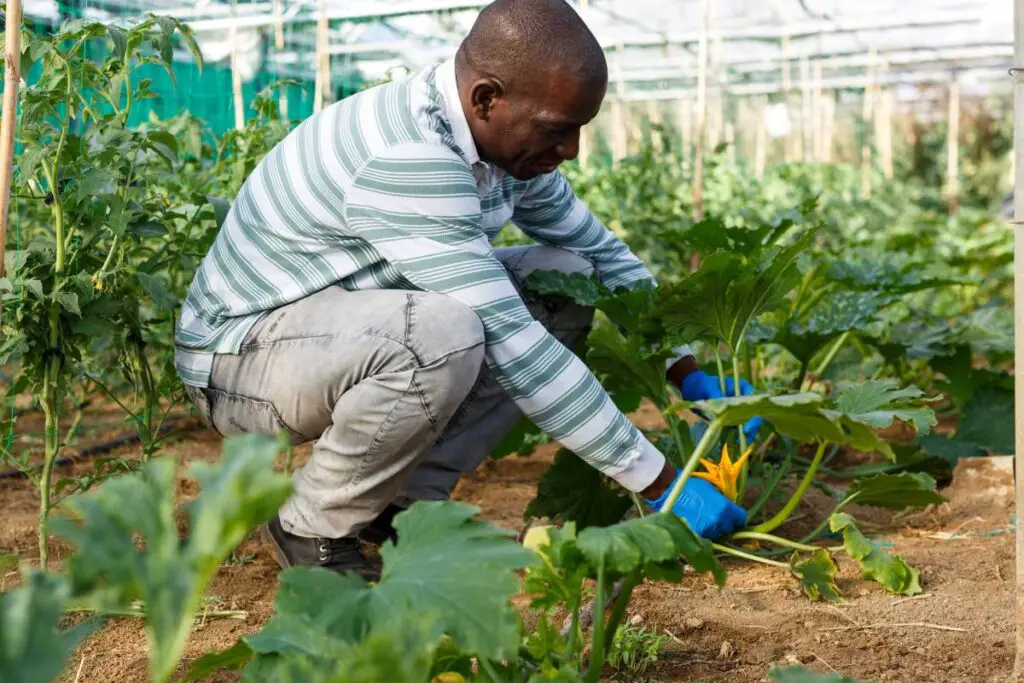Zucchini is a popular summer squash that is easy to grow. Zucchinis have both bush and vine varieties. But a question most beginners ask is whether Zucchinis need support or not.
Whether Zucchinis needs support or not depends on various factors. Most Zucchinis don’t need support, but they would appreciate it. Zucchinis grow heavy fruits, and the plant can fall over due to weight. This support can come to the rescue.
Many Zucchinis will grow without support, while others will need help. Read this article till the end to learn the reasons behind supporting Zucchinis, some ideal supports, and how to provide support.

Zucchini Plant Growth Habits
Zucchinis are famous summer squashes with large green leaves that can grow about 10 inches in diameter.
The plant produces yellow flowers from which the fruits will grow.
Based on the cultivar, the plant can grow as a bush or vine.
The bush varieties are compact and can grow up to 2-3 feet tall, whereas the vine varieties reach 6-10 feet tall.
The plants are very fast-growing plants.
Once the fruits start growing, the production accelerates in no time.
The Zucchinis is 1-2 inches per day and produces around 10 pounds of Zucchinis per plant.
Zucchinis do grow on vine stems that are several feet long.
Still, unlike cucumbers, they do not have any tendrils or crawling habits.
Some Zucchinis stretch far on the garden bed and take up a lot of space on the ground.
That is why many gardeners provide support and train them to grow vertically.
Benefits of Support
I grow my Zucchinis on a separate raised bed.
The only struggle I had was at the time of harvesting.
I had to move in different directions, bending down to pick the Zucchinis.
Moreover, they were pretty messed up by mud.
I had to clean them with a cloth to remove the mud and store them.
Some of my friends grow Zucchinis, too, and they use support.
While visiting my garden one day, they insisted on trying some supports like stakes or trellis and growing them vertically.
My Zucchinis were doing fine, so I never considered providing any support. But still, I tried.
I used some solid 6-foot tall wooden stakes and trained the Zucchinis.
I loved how they have turned out to be.
Visibly, the yield was higher, the fruits were clean and fresh, and harvesting became much easier.
They were receiving more sunlight while growing upwards, which increased the yield.
The best part was I did not have to bend and struggle while harvesting, as I would only walk around and pick the clean fruits.
There are several benefits of providing support to the Zucchini plants:
- When you provide the plant with enough support, the plant does not fall over on the ground due to the weight of the fruits. They can stand straight without touching the ground with support.
- Providing good support to the Zucchini plants will prevent breakage, especially when carrying too many heavy fruits.
- When you provide support to the plant and lift it off the ground, air can circulate more freely than those loitering over the ground.
- With support, the Zucchini leaves and fruits get elevated when they receive equal sunlight, further promoting good fruit production.
- Supported plants provide a neat look to your garden. The plant does not spread all over the ground. As a result, you get clean fruits.
Types of Support

There are several types of support available for Zucchinis that can help the plant climb on it.
Zucchinis can be very heavy. A heavyweight signifies the moisture content in the fruit.
The more heavy it is, the more refreshing and promising it will taste.
So, whichever support type you choose, ensure that it is strong enough to handle the weight of the Zucchinis.
Stakes
Stakes are one of the most common and easy methods of supporting the Zucchinis. It is also cost-effective.
Stakes are wooden or metal poles that you drive directly to the ground next to your Zucchini plant.
You can drive 2-4 stakes near them and tie the plant’s branches or vines with the stake using tape or thread.
After that, the Zucchinis will follow the path of the stake and start growing upwards.
Stakes are handy for small Zucchini plants.
They provide support without overwhelming the plant.
If your plant grows too big with lots of heavy fruits, you need something sturdy or more stakes nearby.
Chain link fencing
Any fencing can work for Zucchinis, and chain link fencing is one of them.
It is also an ideal choice for Zucchinis as it is sturdy and can handle the heavy weight of the fruits.
If you plan to use support for your Zucchinis beforehand, sow the seeds or plant the stems next to a fence.
This way, you can be free from the mess of adding support later.
Cages
Cages are also a famous support structure for Zucchinis. Cages are made with a series of metal or wire hoops surrounding the plant, providing support as its growth increases.
You should use cages if your Zucchinis are spreading too much and taking up much space in your garden.
Cells will control the vines and branches of your plant and support them so that fruits do not touch the ground.
Zucchini leaves can be around 10 inches in diameter. And a tomato cage and keep these leaves elevated, especially when you train them to climb.
You might need to use a stake with the cage to train the Zucchinis to climb above the tomato cage’s rim.
Trellis
Trellis is another excellent option for the Zucchinis.
Trellises can be vertical or arch-shaped.
You will receive several designs of trellis made with different materials.
The structure consists of several posts, wires, and strings that can help the Zucchini plants climb vertically.
Allowing the Zucchinis to grow upwards is one of the most significant benefits of using a trellis.
Zucchinis do not crawl, but they can take up a lot of space in the ground.
Vertical gardening with trellis can prevent this and increase the space of your garden, which can further inspire you to grow more plants.
You can even decorate your garden with these trellises and make your garden the center of attraction of your house.
You can customize them to fit your Zucchini plant and your garden’s needs.
You can even build one with wood, metal stakes, wire, or twine instead of buying.
But that would require experience, essential tools, and much effort.
While choosing a trellis, you must ensure that it is tall and strong enough to handle the weight of the Zucchini fruits.
I suggest using a trellis that is 6 feet tall and 3 feet wide.
Since they can be made of different materials, choose the robust one.
This way, you can receive strong support for the Zucchinis while designing your garden.
Looking for gardening supplies? We have tested 100's of products before recommending them to you guys. Check out our best pick below:
| Image | Gardening Supplies | Best Price? |
|---|---|---|
 Top
Top Top
Top | Raised Garden Bed Kit | Check On Amazon |
 | XLUX Soil Moisture Meter, Plant Water Monitor, Soil Hygrometer Sensor for Gardening, Farming, Indoor and Outdoor Plants, No Batteries Required | No Results |
 Top
Top Top
Top | 82 Pcs Garden Tools Set and Extra Succulent Tools Set | Check On Amazon |
 | Joeys Garden Expandable Garden Hose with 8 Function Hose Nozzle, Lightweight Anti-Kink Flexible Garden Hoses, Extra Strength Fabric with Double Latex Core, (50 FT, Black) | No Results |
 Top
Top Top
Top | Dual Chamber Compost Tumbler | Check On Amazon |
 Top
Top Top
Top | Sunnyglade Plant Stakes | Check On Amazon |
 Top
Top Top
Top | Organic Cold Pressed Neem Seed Oil | Check On Amazon |
 Top
Top Top
Top | Mighty Mint Gallon :-Insect and Pest Control Peppermint Oil | Check On Amazon |
 Top
Top Top
Top | Scotts DiseaseEx Lawn Fungicide | Check On Amazon |
 Top
Top Top
Top | Jacks Classic 20-20-20 All Purpose Fertilizer | Check On Amazon |
 Top
Top Top
Top | 30,000 Seeds Pollinator Attracting Wildflower Mixture | Check On Amazon |
 Top
Top Top
Top | Survival Vegetable Seeds Garden Kit-Over 16,000 Seeds | Check On Amazon |
Choosing the Right Support
There is no single support system for the Zucchinis.
It depends on the gardener and the plant’s condition.
You can choose anyone from the above options. All you need to do is ensure it is tall and sturdy enough to handle the plant’s growth pattern and the fruit’s weight.
I have seen most gardeners grow their Zucchinis on trellis or stakes made of wood or metal.
A-frame trellis is the most common one.
I have made some vine varieties before, and it is the best and easy one.
You can use these metal or wooden stakes to construct a trellis of any shape to support the Zucchinis properly.
The A-frame can support the Zucchinis well, allows them to climb without interruption, and only takes up a little space in your garden.
You can also go for an entirely vertical trellis.
It can save more space than the A-framed trellis.
You can repurpose a tomato cage to support Zucchinis in the pots.
Stakes are also a good choice. Gather some stakes, drive stakes around the plant, and then train the Zucchinis to climb them up.
As I said, not that only one type of support is suitable for the Zucchinis.
You can choose any type that is sturdy, provides good support, saves some garden space, and encourages good airflow.
Ensure that it is 6 feet tall and 3 feet wide.
Also, consider the root system of the plant. Zucchini’s shallow root system can become robust over time, making it challenging to drive the support.
Forcible driving can damage the roots, too.
To avoid this, put your support as soon as the seedling grows and reaches a few inches tall.
When to Provide Support?

The plants are fast growers and can produce fruits after 2 months of planting.
They can grow quite extensive, and the fruits are pretty heavy.
When the Zucchinis begin producing fruits, their developing vines and the fruits can put a lot of stress on the plant, causing damage due to overweight.
That is when the plant will need support.
Start providing support before the plant starts growing fruits.
The time will be a few weeks after you watch the plant grow big leaves and thrive.
The bush varieties are compact and reach only 2-3 feet high.
But the vining varieties can reach around 6-10 feet.
They will face the problem more than the bush varieties.
Supporting them when they are around 6-10 inches tall would be a good idea.
You can also do it right after transplanting or when the seedlings appear.
Since the roots won’t be strong enough at this time, driving the stakes would be easier.
You can also put supports like trellises beforehand and plant the starts or seeds at the base afterward.
Supporting the plant to grow vertically can keep the fruits and the leaves from touching the ground, further preventing rot and soil-borne diseases.
How to Provide Support?
There are several ways to provide support to the Zucchinis.
How you provide it depends on which support method you are using:
Preparing the Garden Bed
Preparing the garden bed involves preparing the soil bed and finding the locations where you want to put the support.
To prepare the soil bed for Zucchinis, till the top few inches of the soil, mix some organic matter and chicken pellet fertilizer to make it fertile.
Mix everything and plant the plants or seeds.
Now, after you sow the starts of the seeds, let them grow a few inches tall, and then you need to find locations for driving stakes.
Find out the suitable locations where you think providing support would support the Zucchinis.
Once you have marked the locations, it is time to install the support system.
Installing Support Structures
Based on the kind of support you have chosen, you can drive the stakes, install the trellis into the ground, or attach it to the nearby fence or wall.
Stakes
It is an easy and cost-effective support system.
After transplanting the Zucchinis or a few days or weeks after the seeds sprout, carefully drive the 6-foot-long metal post or wooden stake 1-2 inches deep into the soil, away from the stem.
Give the stems some space so the Zucchini leaves can grow and reach their correct size and the flowers can grow without interruption.
Secure the plant to the stake using a string once the Zucchini reaches 4-6 inches tall.
Do not use any narrow bamboo stake or a single lightweight stake.
This kind of support will not be strong enough to carry the weight of the plants.
Cage
You must first get the right size to use a tomato cage for your Zucchini plants.
They come in various sizes.
Buy one large enough to support your Zucchini plant.
Place the cage around the plant.
Ensure the cage’s bottom stays 2 inches away from the plant stems.
Secure the tomato cage using stakes or large rocks and keep it in place.
Make sure the stakes or rocks stay firmly in the ground.
As the plant grows, it will climb to the top of the cage.
You can prune some leaves to keep the plant within the cage’s confines.
Regularly check the plant and the cage.
If you think the cage needs more support, add more stakes or rocks to keep it in place.
Trellis
You can buy an entirely constructed trellis with your preferred design and shape or make one using stakes, wires, strings, and other materials.
Put up the trellis first and then sow or plant the Zucchinis.
Trellises have several shapes and sizes: wooden trellis, arch-shaped trellis, or t-posts with wire mesh.
Let’s say you have planted the Zucchinis and want to put a pre-constructed trellis you bought from the market.
It might happen that one end of the trellis is placed over the plant.
In that case, you will have to shift the plant to place the trellis properly.
Instead of doing this, put the trellis first, and then plant or sow the Zucchinis.
Choose a trellis in your garden and secure it well with more stakes or rocks.
Then, plant the seedlings or sow the seeds at the base of the trellis.
Space them according to the recommendations provided in the packets.
A minimum of 2-3 feet of space is recommended.
Once the plant starts growing, the vines, branches, and leaves train, and tie the vines to the trellis with a string.
It will encourage your Zucchini plant to grow vertically.
Tying and Training Zucchini Vines
Zucchinis do have vines that can climb up the support.
But they are not natural climbers.
You have to tie and train the Zucchini vines to help them climb up the support.
Once the plant reaches a few inches tall, tie the vines to the support with a string.
You do not have to tie them tightly; you will only train the Zucchinis to climb up.
Throughout the season, you must keep tying the Zucchini plant every few inches and get the plant to lean on the support.
If the fruits are heavy and the plant seems drooping, you must secure more points along the stem to prevent the plant from bending.
If there are not enough ties, or the support is weak, the plant will start leaning towards the ground.
Avoid using any rough material to tie the plant to the support.
That will damage the stem.
If the fruits seem heavy and your support doesn’t feel enough, use some slings made from soft fabric.
Secure the slings to the support to hold the fruits in place.
You can even add extra stakes close to areas where the plant will need support.
Air Circulation and Disease Prevention
As the plant grows, trim some leaves from the plant.
It will help increase air circulation and prevent diseases.
Since the plant grows huge leaves, too many leaves can suffocate the plant and increase humidity.
Unfortunately, the plant will suffer from powdery mildew.
Over time, it can also invite other pests and lead to infestation and diseases.
To prevent this, remove some leaves as they grow, especially the lower leaves, below the flowers, and dead and yellow leaves.
It will increase air circulation and force the plant to focus on growing healthier leaves and fruits.
Do not remove too many leaves; otherwise, the plant will get stressed.
Harvesting and Maintenance

Maintaining the Zucchini plant is essential to receive a healthy and tasty harvest.
Once you have put up the stakes and planted your Zucchinis, it is time to nurture them well for healthy fruit production.
Sunlight
Ensure the plant receives around 6 to 8 hours of sunlight daily.
Even 4-6 hours will work in the case of vertical gardening because they will grow towards sunlight and receive the maximum equally.
Water
Provide adequate water after you have tied the Zucchini vines and branches to the stakes.
It is essential for the plant’s growth, especially for those growing with the help of support.
Keep the soil evenly moist, especially during the hot and dry weather.
Check the moisture level with your finger by dipping it 1-inch deep into the soil. If it feels dry, water the plant.
Fertilizer
When you prepare the garden bed, you are already preparing the soil with fertilizer and organic matter.
You do not have to fertilize immediately after planting.
Once the plant reaches a few inches tall, you can fertilize it with a balanced liquid fertilizer every 2-3 weeks.
Once the plants have established, started growing up with the support, and produce fruits, provide additional 1-2 pounds of fertilizer per 100 square every 3-4 weeks.
Support Maintenance
Along with the plant, you must also maintain the support system.
Regularly check the support system and see if it is doing well.
Metal stakes can remain wet when regularly watering the plant, leading to rust.
Check for these signs, and try to remove the rust using sandpaper.
You can also use stainless steel instead of metal stakes.
Wooden stakes can also be risky.
But in this option, you can make it waterproof using good-quality sealants, like linseed oil, Spar Urethane, or Thompson’s Water Seal.
Clean the wood, let it dry, apply a thin sealant layer, let it dry overnight, and then use it for support.
Regularly inspect whether your support is enough or more support is needed.
Harvest
Once the plant has produced fruits, harvest them when they reach around 6-8 inches tall and 2 inches in diameter.
Since Zucchinis are fast growers and producers, you must harvest them every other day.
Keeping the fruits on the plant for too long makes the fruit hard and inedible and also reduces the plant’s ability to produce.
If you have picked any unripe Zucchinis by mistake, you can ripen them off the vine.
Please keep them in a sunny area with warm temperatures and standard or slightly high humidity.
Using a knife, cut the Zucchini, leaving 1 inch of stem in the fruit.
This will prevent rotting. You can store them in the fridge for 7-14 days later.
Benefits of vertical gardening
There are several benefits of vertical gardening:
- With vertical gardening, Zucchinis will take up less space in your garden. As a result, you get more space to grow some more plants.
- When you grow the Zucchinis vertically with support, you save them from various pests and diseases spread from the ground.
- When you grow them vertically, plants can enjoy a better breeze, increasing air circulation and reducing the chances of diseases like mildew.
- With vertical gardening, you do have to walk through the plants and bend down to harvest the fruits. You can easily collect them by walking around.
- When you grow Zucchinis vertically, the fruits stay above the ground. It keeps the fruit clean and away from pests that love munching anything.
- With vertical gardening, the plants grow upwards. It makes sunlight more available for the plants. And Zucchinis will love it.
- Since the plant will stay healthy with vertical gardening, the plant will have better yields than those spreading over the ground.
Potential Drawbacks or Challenges
While providing support to the Zucchinis is filled with advantages, there are a few challenges to face in this process:
Weak support
Since you will provide support to a plant like Zucchini that bears quite heavy fruits, use strong support.
If the support is not strong enough, the plant can still lean and bend down, causing breakage and more harm.
Metal stakes can rust, and wooden stakes can rot.
Use wooden stakes coated with suitable sealants or stainless steel stakes to fight this challenge.
Lack of air circulation
Growing Zucchinis vertically with a support system can undoubtedly increase air circulation.
But even with support, there are chances of low airflow when they are growing vertically.
When you train them to grow vertically, the leaves can get packed vertically and reduce airflow, causing mildew.
So, you have to prune the plant regularly and occasionally remove the lower leaves and dead and damaged leaves to increase air circulation.
Squash bugs
Even if the plants will stay above the ground, pests can still attack your plants.
While you are saved from most pests, squash bugs are the common ones that can attack the Zucchinis, even during vertical gardening.
These bugs feed on the leaves and vines, damaging the plant’s health and development.
You can either handpick them or use organic pesticides and insecticides to remove them.
Final thoughts
It is not mandatory to provide support to the Zucchinis. They are not natural climbers and can grow without support on the ground. But Zucchinis will appreciate the support you provide them. With support, you can help the plant to carry the heavy fruits without falling off.
When you provide support, the plant stands straight despite carrying those heavy fruits, preventing the chances of fallover or breakage. There are several types of support: cages, trellis, fencing, and stakes. You can choose any one of your choices. Make sure to secure the support system properly.
Once the Zucchini grows, tie some vines to the support with a thread or string to train them. Protect the plants by providing proper water, sunlight, and fertilizer. Harvest them when they reach 6-8 inches tall and 2 inches in diameter. Check the support system regularly to ensure they are doing their job well.
What type of stake will be the best one for Zucchinis?
The stake should be solid and provide enough support to the Zucchinis. You can use a wooden or metal solid stake.
What type of trellis would be suitable for Zucchinis?
Trellis comes in different shapes and sizes. You can choose anyone of your choice. Some recommendations are A-frame trellis, Cattle Panel trellis, T-post and String trellis, and Tomato Cage trellis.
Reference: Zucchini Wikipedia
